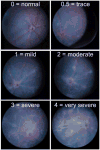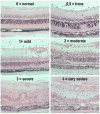Rodent models of experimental autoimmune uveitis
- PMID: 22933083
- PMCID: PMC3810964
- DOI: 10.1007/978-1-60761-720-4_22
Rodent models of experimental autoimmune uveitis
Abstract
The model of experimental autoimmune uveitis (EAU) in mice and in rats is described. EAU targets immunologically privileged retinal antigens and serves as a model of autoimmune uveitis in humans as well as a model for autoimmunity in a more general sense. EAU is a well-characterized, robust, and reproducible model that is easily followed and quantitated. It is inducible with synthetic peptides derived from retinal autoantigens in commonly available strains of rats and mice. The ability to induce EAU in various gene-manipulated, including HLA-transgenic, mouse strains makes the EAU model suitable for the study of basic mechanisms as well as in clinically relevant interventions.
Figures




References
-
- Caspi RR. Basic mechanisms in immune-mediated uveitic disease. In: Lightman SL, editor. Immunology of eye disease. Ch. 5. Kluwer Academic Publishers; Lancaster, UK: 1989. pp. 61–86.
-
- Caspi RR, Roberge FG, McAllister CG, el Saied M, Kuwabara T, Gery I, Hanna E, Nussenblatt RB. T cell lines mediating experimental autoimmune uveoretinitis (EAU) in the rat. J Immunol. 1986;136:928–933. - PubMed
-
- Gery I, Robinson WG, Jr, Shichi H, El-Saied M, Mochizuki M, Nussenblatt RB, Williams RM. Differences in susceptibility to experimental autoimmune uveitis among rats of various strains. In: Chandler JW, O’Conner GR, editors. Advances in immunology and immunopathology of the eye; Proceedings of the third international symposium on immunology and immunopathology of the eye; NY: Masson Publishing; 1985. pp. 242–245.
-
- Nussenblatt RB, Whitcup SM, Palestine AG. Uveitis: fundamentals and clinical practice. 2. Mosby - Year Book, Inc.; St. Louis, MO: 1996.
-
- Gery I, Mochizuki M, Nussenblatt RB. Retinal specific antigens and immunopathogenic processes they provoke. Prog Retinal Res. 1986;5:75–109.
MeSH terms
Substances
Grants and funding
LinkOut - more resources
Full Text Sources
Other Literature Sources
Medical
Research Materials

